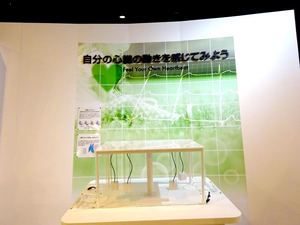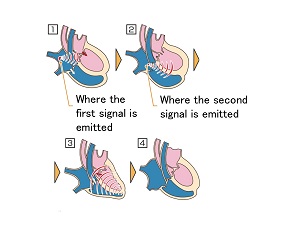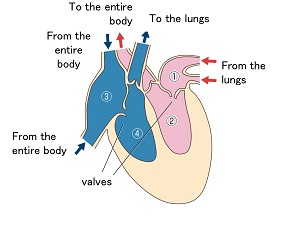Nagoya City Science Museum
TOP > Exhibition Guide > Floor Map> Feel Your Own Heartbeat
Feel Your Own Heartbeat



Purpose of Exhibition
Place a stethoscope over your heart, and you will find that a small box in front of you vibrates to the rhythm of your heartbeats. Touch the box and feel the rhythm of your heartbeats firsthand.
Try again after some physical exercise, and you will feel the quickened beat of your heart.
One stethoscope is connected to two small boxes, so that the motion of your heart can be shared with somebody else.
Your heartbeat changes depending on circumstances, and it varies from person to person. This exhibit enables you to feel firsthand that you are “alive.”
To fully enjoy this exhibit, be sure to place a stethoscope almost on the middle of your chest (slightly to the left) and keep quiet. If you use your voice, its vibration is also conveyed.
Additional Knowledge
[Why do the boxes vibrate?]
The vibrations caught by a stethoscope microphone are conveyed to a vibration-generating (not sound-generating) speaker. To prevent the speaker from responding to voices and other noises, the device in this exhibit has a mechanism that screens out such noises to some extent.
[Where is the heart located?]
Please look at the illustration showing how to use. A stethoscope is placed almost on the middle of the chest. You may just wonder why, because you know that your heart is located in the left side of the chest. In reality, however, your heart is located in the middle of the chest, and the lower end of the heart is located slightly to the left, where you can feel your heartbeats easily. Please check the location of the heart using the human internal organ model and related materials.
[How does the heart beat out a rhythm to pump blood to the rest of the body?]
The heart contracts by itself, without any stimulus from outside, to generate the pressure to drive blood flow. Inside the heart, there is an area responsible for creating and controlling a rhythm, from which an electrical signal is sent to other parts of the heart to systematically pump blood to the rest of the body.
[Is the heart a house with four chambers?]
The heart has four rooms: a pair of the room called “atrium,” which collects the blood that come back to the heart, and the room called “ventricle,” which pumps out blood throughout the body, on the right and left sides respectively.
The four rooms of the heart are called:
1. Left atrium
2. Left ventricle
3. Right atrium
4. Right ventricle
Of these, the left ventricle is a chamber with the thickest wall.
Blood travels in this order: 1 2 throughout the body 3 4 lungs 1
This is called the “circulation of blood.”
Cooperation by:
Hideyuki Ando (Graduate School of Information Science and Technology, Osaka University)
Junji Watanabe (NTT Communication Science Laboratories)
Article by Tomoko Horiuchi, curator
